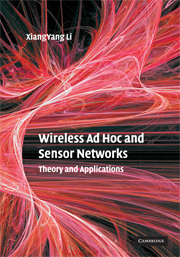Book contents
- Frontmatter
- Contents
- Preface
- Acknowledgments
- Abbreviations
- Part I Introduction
- Part II Wireless MACs
- Part III Topology Control and Clustering
- Part IV Wireless Network Routing Protocols
- 13 Energy-Efficient Unicast Routing
- 14 Energy-Efficient Broadcast/Multicast Routing
- 15 Routing with Selfish Terminals
- 16 Joint Routing, Channel Assignment, and Link Scheduling
- Part V Other Issues
- Bibliography
- Index
16 - Joint Routing, Channel Assignment, and Link Scheduling
from Part IV - Wireless Network Routing Protocols
Published online by Cambridge University Press: 06 July 2010
- Frontmatter
- Contents
- Preface
- Acknowledgments
- Abbreviations
- Part I Introduction
- Part II Wireless MACs
- Part III Topology Control and Clustering
- Part IV Wireless Network Routing Protocols
- 13 Energy-Efficient Unicast Routing
- 14 Energy-Efficient Broadcast/Multicast Routing
- 15 Routing with Selfish Terminals
- 16 Joint Routing, Channel Assignment, and Link Scheduling
- Part V Other Issues
- Bibliography
- Index
Summary
Introduction
Wireless multihop radio networks such as ad hoc, mesh, or sensor networks are formed of autonomous nodes communicating via radio. Wireless networks have drawn lots of attention in recent years because of their potential applications in various areas. For example, wireless mesh networks (WMNs) are being used as the last mile for extending Internet connectivity for mobile nodes. Many U.S. cities (e.g., Medford, Oregon; Chaska, Minnesota; and Gilbert, Arizona) have already deployed mesh networks. AWA, the Spanish operator of WLANs, will roll out commercial WLANs and mesh networks for voice and data services. Several companies, such as MeshDynamics, have recently announced the availability of multihop, multiradio mesh-network technology. These networks behave almost like wired networks because they have infrequent topology changes, limited node failures, and so forth. For WMNs or WSNs, the aggregate traffic load of each routing node also changes infrequently. A unique characteristic of wireless networks is that the radio sent out by a wireless terminal will be received by all the terminals within its transmission range and also possibly cause signal interference to some terminals that are not intended receivers. In other words, the communication channels are shared by the wireless terminals. Thus, one of the major problems facing wireless networks is the reduction of capacity that is due to interference caused by simultaneous transmissions. Using multiple channels and multiple radios can alleviate but not eliminate the interference. This raises the scalability issue of WMNs.
Information
- Type
- Chapter
- Information
- Wireless Ad Hoc and Sensor NetworksTheory and Applications, pp. 440 - 460Publisher: Cambridge University PressPrint publication year: 2008
